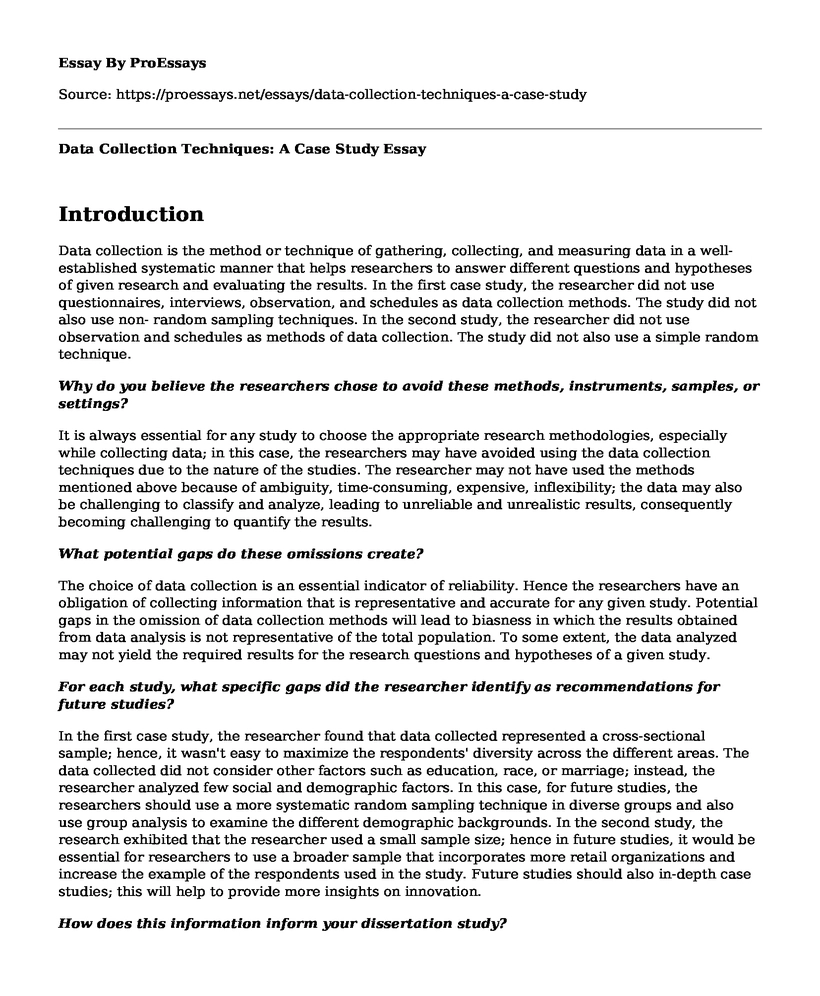Introduction
Data collection is the method or technique of gathering, collecting, and measuring data in a well-established systematic manner that helps researchers to answer different questions and hypotheses of given research and evaluating the results. In the first case study, the researcher did not use questionnaires, interviews, observation, and schedules as data collection methods. The study did not also use non- random sampling techniques. In the second study, the researcher did not use observation and schedules as methods of data collection. The study did not also use a simple random technique.
Why do you believe the researchers chose to avoid these methods, instruments, samples, or settings?
It is always essential for any study to choose the appropriate research methodologies, especially while collecting data; in this case, the researchers may have avoided using the data collection techniques due to the nature of the studies. The researcher may not have used the methods mentioned above because of ambiguity, time-consuming, expensive, inflexibility; the data may also be challenging to classify and analyze, leading to unreliable and unrealistic results, consequently becoming challenging to quantify the results.
What potential gaps do these omissions create?
The choice of data collection is an essential indicator of reliability. Hence the researchers have an obligation of collecting information that is representative and accurate for any given study. Potential gaps in the omission of data collection methods will lead to biasness in which the results obtained from data analysis is not representative of the total population. To some extent, the data analyzed may not yield the required results for the research questions and hypotheses of a given study.
For each study, what specific gaps did the researcher identify as recommendations for future studies?
In the first case study, the researcher found that data collected represented a cross-sectional sample; hence, it wasn't easy to maximize the respondents' diversity across the different areas. The data collected did not consider other factors such as education, race, or marriage; instead, the researcher analyzed few social and demographic factors. In this case, for future studies, the researchers should use a more systematic random sampling technique in diverse groups and also use group analysis to examine the different demographic backgrounds. In the second study, the research exhibited that the researcher used a small sample size; hence in future studies, it would be essential for researchers to use a broader sample that incorporates more retail organizations and increase the example of the respondents used in the study. Future studies should also in-depth case studies; this will help to provide more insights on innovation.
How does this information inform your dissertation study?
The information tells that the dissertation study may not provide the required outcomes; this is because the omissions create gaps that may lead to unreliable and unrealistic results of the dissertation study. Therefore, the researchers must consider representative sample size and appropriate research methodologies such as data collection, measurement, and analysis.
References
Cao, Y., Ajjan, H., & Hong, P. (2018). Post-purchase shipping and customer service experiences in online shopping and their impact on customer satisfaction. Asia Pacific Journal of Marketing and Logistics.
Olsson, A., B. Paredes, K. M., Johansson, U., Olander Roese, M., & Ritzén, S. (2019). Organizational climate for innovation and creativity–a study in Swedish retail organizations. The International Review of Retail, Distribution and Consumer Research, 29(3), 243-261.
Cite this page
Data Collection Techniques: A Case Study. (2023, Aug 17). Retrieved from https://proessays.net/essays/data-collection-techniques-a-case-study
If you are the original author of this essay and no longer wish to have it published on the ProEssays website, please click below to request its removal:
- Personal Reflection on English 101 Course
- Action Research and Organizational Development Essay
- Causes and Impacts of Racial Microaggressions and How Black Female Students Integrate These Experiences
- Exploring Childhood Identity: Interviews With Two Children and Their Mothers - Essay Sample
- Essay Example on Developing Language & Literacy: My Journey
- Free Essay Example on Getting Back on Your Feet: Post-Illness Advice from a Patient
- Essay Sample on Healthcare Workers During This Covid-19







